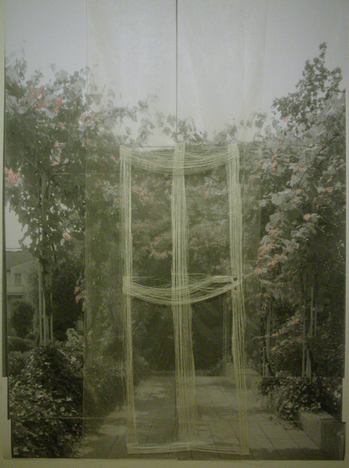KEI TAKEMURA “DEAREST UNKNOWN YOU”
HAPPENINGText: Yu Miyakoshi
Coinciding with Kei Takemura‘s solo exhibit, “dearest unknown You” (Taka Ishii Gallery in Kiyosumi-shirakawa, Tokyo), is the release of a text with the Berlin-based artist’s thoughts, revealing the creative individual facing her work in a very real sense.
“It was when I gave birth to my child. After experiencing a tiresome amount of pain, I suddenly felt deceived. I was eager with the thought that the process of giving birth was an act which was the closest of ‘life’ however, I understood in that moment that I was standing in a place that was most close to ‘death.’
The day of the earthquake. It was just after noon on the second day of being back in my family home in Tokyo, upon accompanying my husband who had come for work. The house was shaking, so much that I clutched my son within my arms and went outside. The tree which stood in front of the house was shaking alarmingly.
Every day there was footage of extreme destruction on television. After returning to Berlin, I saw a lot of photographs of the areas that had experienced damage. In German newspapers and magazines, there were photographs showing the bodies of those who had passed away, with images of the destroyed towns in their background. To myself, who had believed that within photographs the souls of those who are captured are somehow preserved, it was unbelievable to witness the bodies of unknown people in such a way.
Up until then I had been interested in the lives of those whom I knew, but the experience of ‘that moment’, led to my interest in the lives of people whom I did not know. I went to a nearby market in Berlin and collected photographs taken by people whom I did not know. The images captured within the photographs taken by unknown people, varied in time periods, ranging from the 1920’s up until the 1980’s however, they somehow all connected to the landscapes I was familiar with.” – Quoted (with partial omissions)
After the March earthquake, Takemura bought photographs from a market in Berlin, and began drawing based on those images. Before, for Takemura, the deceased seemed to belong only to close friends and families of those who had passed away. But the media coverage shook up such previous notions. At the same time, a love towards even those she did not know began to well inside the artist.
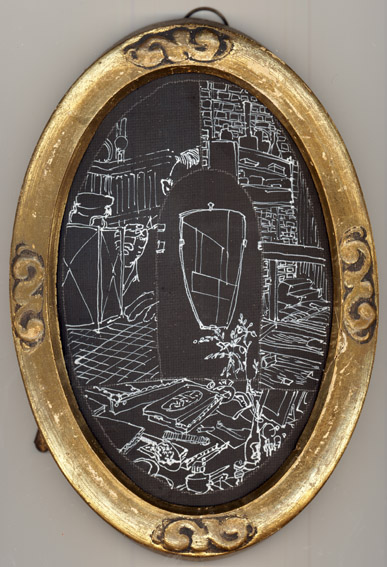
“prosaic verse” (detail) 2011. Courtesy of Taka Ishii Gallery. Photo: Kenji Takahashi
The pieces that she drew out of such feelings comprises the series introduced in this exhibition, “prosaic verse.”
What was left after the March disasters, the “feeling that everything was lost,” is expressed in the black background that has replaced the original white, and the white ink evokes a sense of déjà vu. The man with glasses with his head cocked to one side, the cat with its arched back, the flower placed in an empty bottle—ordinary everyday scenes appear and are resurrected as new images.
In addition to the drawings, there are furniture pieces collected from markets in countries like the Netherlands, Belgium, and Italy. By placing furniture in the exhibit, Takemura attempted to create a space that fits the lives of those she did not know.
“I wanted to create a situation that could convey the everyday beauty they saw. For me, sharing feelings is beautiful; it creates possibilities for communicating.”
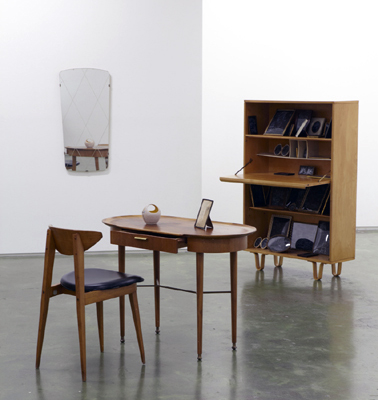
“prosaic verse” 2011. Courtesy of Taka Ishii Gallery. Photo: Kenji Takahashi
Until creating these pieces, photographs sold at markets frightened her. In Japan, framing photographs for display is not a familiar custom, and such practice evokes pictures placed in family altars and portraits of dead ancestors. Drawing based on such photographs was like shining a ray of light onto a black background—a process that seemed to affirm the presence of the deceased being drawn in the same space. Takemura says, “either dead or alive, I wanted to recognize that everything that exists ‘is.’ Everyone lives in parallel now. Instead of feeling fear, I was drawing with the sense of ‘everyone is welcome,’ and the photographs from the markets no longer incited fear in me.”
There is a photography genre called, “found photography.” Its definition seems to vary from time to time, but in general refers to pictures discovered in places and situations like flea markets or photographs reworked as visual art and presented by artists.
The exhibition “prosaic verse” is an installation based on Takemura’s “found photographs.” She did not extract directly from the impulses she felt from the March 11th disasters, but she decided to express such impulses through wider interests around her.
What Takemura wanted to create was perhaps a space for souls—with nowhere to go — to come down and console each other. The basis of this vision was the news coverage during the disasters: the sorrow and mourning she witnessed towards the deceased and what grew out of such feelings was her resolve, as an artist, to express life-like artwork straight from her own life situations. It can also be said that the act of “creating a space” was Takemura’s search for her own space. For those living in a foreign country, unless they re-seek their own space, there is nowhere to go. Takemura, in such an ambivalent position herself, perhaps attempted to create a place for all the displaced individuals she saw in the earthquake coverage and the photographs from the market.
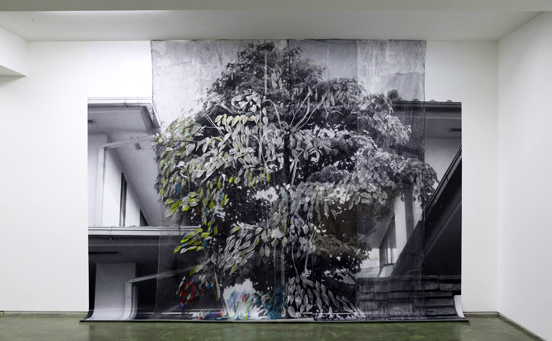
“between tree, ghost has come” 2011. Courtesy of Taka Ishii Gallery. Photo: Kenji Takahashi
A large piece that reaches the gallery’s ceiling, “between tree, ghost has come,” also went through a transformation after the earthquake. The pictures used for the background of this piece are of Takemura’s parents and grandmother’s homes, and the great tree standing between the two houses is a collage with an organdy-like transparent cloth draped over.
Looking back on her past production style, Takemura says, “I used to think that ‘things’ simply moved from place to place. If you pull out the strings from embroideries, all the pieces return to their original forms, which is best for them. Works simply result from ‘things’ moving from one place to another.” The artist perhaps held a sense of aesthetics in which she wanted to leave the natural beauty of things, in their original forms. After the disasters, however, Takemura dyed fabric for the first time.
“Before, I had absolutely no wish to dye cloth. But when I was in Tokyo and the nuclear accident occurred, I was terrified to allow my child to go outside. I thought about the existence of air for the first time, and the polluted air felt like reality, and I felt like dying cloth would be the best way to express that.”
As the artist claims that she “creates pieces by moving things,” Takemura’s stance towards her work is based on moving, collecting, extracting and imitating.
Most of all, the act of “imitating” epitomizes Takemura’s production stance. She has a performance act called “May I enter?” meaning “can I get inside of you?” She observes friends’ everyday lives, and she copies their actions. The invisible Takemura, in the process of assimilating into her subjects, transforms the boundaries between her subjects and her internal side into her own expression. In this way, it seems like the foundation of her expression lies in this act of observing her subjects through her own filter.
Another reality begins to form in the space between such collected imitations and the space between gathered objects. Having produced her work with such attitude, Takemura’s adoption of altering the color of natural materials signifies a major change.
In “between tree, ghost has come,” among the grey hues, a breath of color begins to appear. The vivid image resembles a monochromatic dream, and seems to link to the sense of consciously recognized colors. For example, the blind pianist Nobuyuki Tsujii’s statement that he “likes the color blue” was mind-blowing. Sounds and smells and textures—these various senses seem to capture color tones. Takemura’s grey holds a transparency that releases color traits, especially since the colors are not simplified.
Embroidery adorns fabric. The embroidery is intended to create a “temporary” situation, but Takemura seeks to sew images that will last for a thousand years. “When I saw the embroidery piece called tenjyukoku shuchou from the Asuka Period at Chuguji temple in Nara Prefecture, I was struck by the existence of a piece of embroidery from over a thousand years ago, and wanted to create an image that would exist a thousand years from now. Also, silkworms die producing silk threads; there is a transformation in life. I feel a sense of responsibility that I cannot just create any image.”
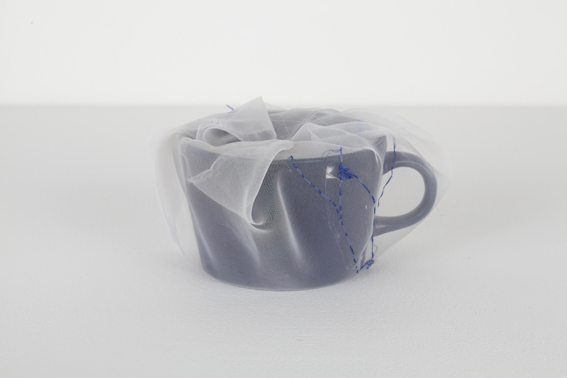
“Renovated K.Tʼs coffee cup”. Courtesy of Taka Ishii Gallery. Photo: Kenji Takahashi
The act of sewing has been a recurring process in her work since the series on restoring broken items, which began around the year 2000. The series entails wrapping broken pottery with cloth and sewing it all with silk threads, as if mending the shattered pieces. The expressive verbosity seen in her drawings are not to be seen in this series, but instead, the works here simply present everyday happenings where “objects break.”
“I don’t like to simply throw objects away, because the only thing that remains is the sadness that something was broken. I also don’t like ‘disliking something,’ whatever it may be. I believe there is a positive aspect to everything,” says the artist, who focuses on the quotidian in general — from the ordinary to sudden happenings. This series still continues today, and Takemura’s attitude towards her work remains unaltered and ensconced in her everyday life; it is as if these pieces are sketches of her usual day.
Reflecting on Takemura’s work, there were three turning points. The first, as mentioned earlier, was becoming a mother, and the third was becoming interested in strangers after the March 2011 disasters. Between the first and third turning points was the “illusion incident” that took place when she stayed at contemporary dancer Yoko Ando’s home.
In 2009, to work on her performance “May I enter?” Takemura enjoyed a sojourn at Ando’s temporary residence in Dresden. After returning to her own home, Takemura wanted to create a piece based on her memories of her stay with the dancer, and she drew the memorable pink flowers that were blooming above the arch of Ando’s home (Dresden dream, 2009).
However, upon inspecting a photograph from her stay in Dresden, Takemura found that there were no pink flowers. For Takemura—who was attempting to create a piece that would remain a thousand years in the future, and was therefore not concerned with colors that would eventually fade—this discovery came as a shock. A flower’s color, which is so ephemeral that it is described as “already faded away” in a classic Japanese verse, was clearly imprinted in her memory. Since this incident, Takemura began to believe that “what composes a person’s life is not reality, but ‘how he or she sees things.'” From then on, she began using colors more boldly.
“Dresden dream” 2009. Courtesy of Taka Ishii Gallery. Photo: artist
What is intriguing about this incident is that when the artist realized that she had imagined the flowers, her misconception became more real and consistent with her memory. The color Takemura had in mind at the time was directly expressed on paper. The pink tone became an omnificent force that drew together her emotions, the colors she envisioned in her mind, what she wished to express, and the hues of paint she used. For an artist who usually struggles selecting shades of paint, this was most likely an exhilarating experience. It is apparent that this creation, paradoxically, was possible due to an illusion, and it ultimately led to drastically altering the artist’s sense of value. An intense experience, brought on by an unconscious imagination, can at times jolt one’s head, which had been leaning towards rationale, back to reality.
Takemura’s work has progressed through three turning points, and has become stronger and more universal. Her work, which had a very visible delicateness in its early stages, has become more vivid. And the artist’s interest in those close to her has spread to include strangers, and her expressions have become bolder.
What can be observed in such transitions is what it means to live and be human. Takemura has lined up everything she encountered in her life—and even gathered what had fallen through the cracks—and opened up this space with the sentiment that “everyone is welcome.” There, as apparent in her statement that “silkworms die producing silk threads; there is a transformation in life,” her work holds a strength that tries to shine light onto all.
When Takemura talks about themes, “déjà vu” is a keyword. “For me, déjà vu is a vision that has been accentuated,” says the artist. Displaying pictures of her friends and family and found photography in her studio, and infusing her own memories, images begin to form. At times, as attempted in “between tree, ghost has come,” she chronologically explores the 1920s when her grandmother was a child and the 1980s when the artist herself was a young girl. At other times, she travels across time through found photography. In the space between layers of such works, an air-like stratum appears as an alternate reality. Takemura gathers such alternatives, and creates a single space. Visitors, when presented with such a place, see an illusion. Among the many images, they feel as if they have spotted their own experience. Was “May I enter?” an imitation? Or was it the audience that entered the work? It is like déjà vu and paramnesia. However, if it is not reality, what is it? Everyone lives their lives misconceiving and confirming, and in the end, wanting to focus on what is expressed inside of reality rather than reality.
Kei Takemura “dearest unknown You”
Date: January 21nd – February 10th, 2012
Open Hours: 12:00 – 19:00 (Closed on Sundays and Mondays)
Place: Taka Ishii Gallery
Address: 5F, 1-3-2 Kiyosumi, Koto-ku, Tokyo
Tel: +81 (0)3 5646 6050
https://www.takaishiigallery.com
Text: Yu Miyakoshi
Translation: Makiko Arima
Photos: Kenji Takahashi and the artists, Courtesy of Taka Ishii Gallery

